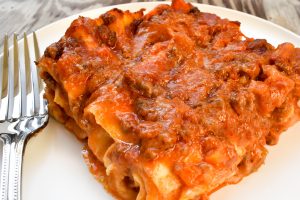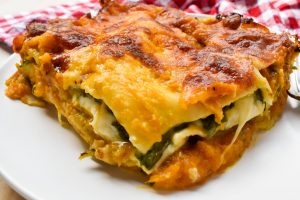Traditional Lasagna: How do you make the best lasagna (lasagne)?
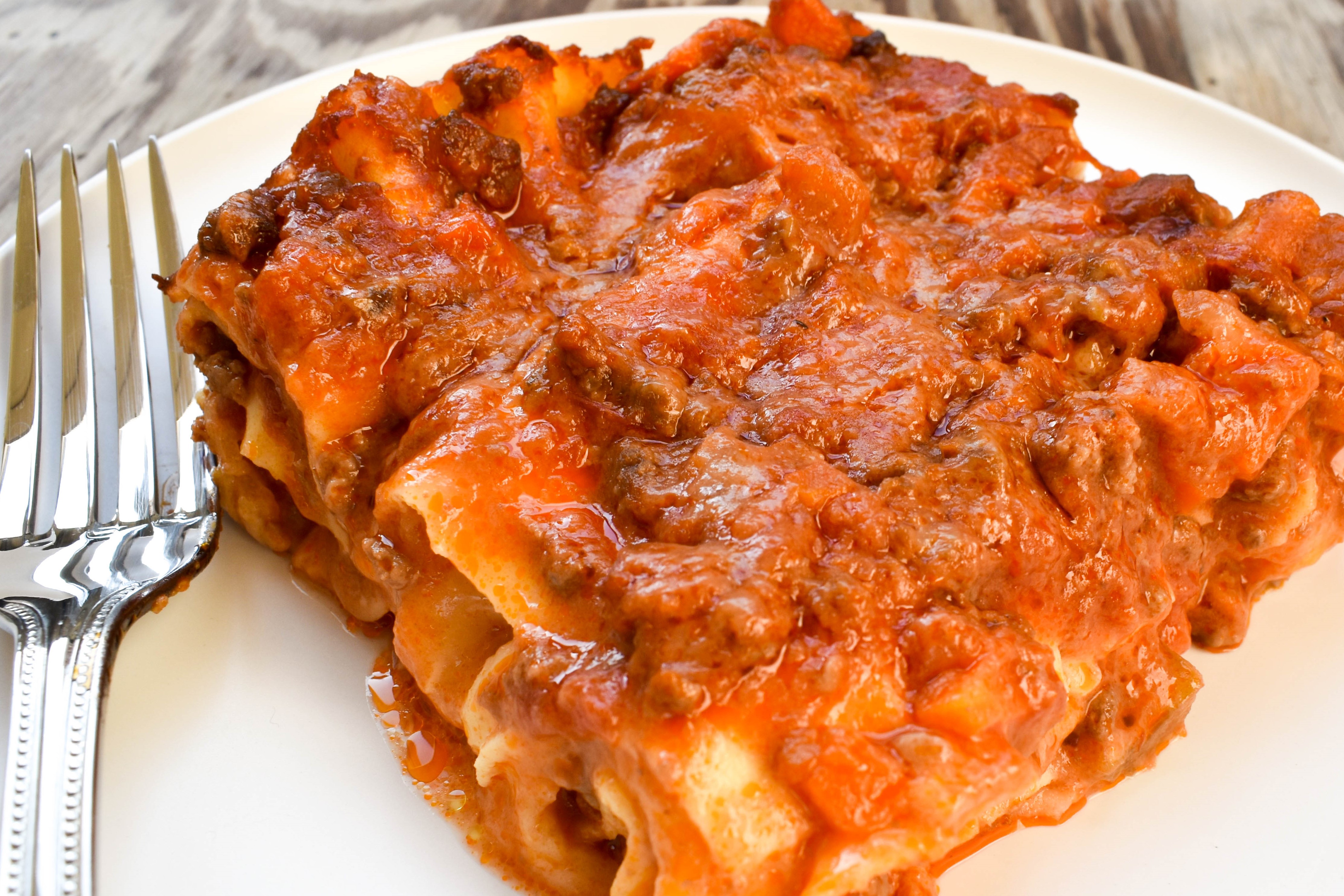
Do you love lasagne as much as we do? Are you looking for delicious vegetable or meat based lasagne ideas? Do you want to know tips and tricks to create the best lasagne? From the hearty Traditional Meat lasagne to Vegetable lasagne, we’ve got recipes to suit everyone’s palette! This blog post is dedicated to all the lasagne lovers out there
Lasagne is known to have originated in Naples Italy. It is one of the most popular dishes in Italy and loved throughout the world. Lasagne is made using layers of pasta sheets alternated with other ingredients such as sauces, meat, vegetables and cheese, then oven baked. You may be thinking what is the difference between ‘lasagna’ and ‘lasagne’? To answer your question, lasagne is the plural form of lasagna. As the dish requires multiple layers, we refer to the dish as lasagne. However you may wish to name it, we have the best lasagne recipes to impress friends and family, starting with Italian Spoon’s Traditional Meat lasagne, the ultimate Italian comfort food with layers of pasta, Ragù alla Bolognese (Bolognese sauce) and Besciamella (Bechamel) sauce. Our recipe never fails – I can guarantee it will be your ‘go to’ recipe.
The question is how do you make the best lasagne? It starts with the perfect sauce, use of fresh egg pasta, careful assembly of the fillings and lastly cooking and resting the lasagne.
The perfect sauce or cream
The difference between a good lasagne and the best lasagne recipe starts with the sauce or cream. There is nothing better than a home-made Ragù alla Bolognese (Bolognese sauce) or fresh Italian tomato sauce for lasagne. My tip is to prepare your sauce first thing in the morning or even 1 day earlier and refrigerate until ready to use. This applies to all sauces whether it be Ragù, fresh tomato sauce or Besciamella (Bechamel) as it allows the sauce time to cool.
If you weren’t born into an Italian family with Nonna’s secret recipe handed down from generation to generation, do not despair. At Italian Spoon, we have the best and the only recipes your will ever need. So, you may be asking ‘which sauce should I use to make the best lasagne?’
For vegetable-based lasagne, I love to make a home-made fresh tomato sauce. During summer when tomatoes are in season, I usually buy Roma tomatoes – they are so much sweeter and make the perfect sauce. Be sure to use extra virgin olive oil, onion, a whole garlic clove, basil, a pinch of salt and Nonna’s secret ingredient to your Italian tomato sauce – a teaspoon of sugar. If you are making lasagne at another time of the year, use canned San Marzano tomatoes.
For meat-based lasagne you cannot go wrong with a Traditional Meat lasagne, using a combination of beef and pork mince meat (ground meat). You can also make a beautiful duck, veal or pork sausage ragù – the choices are endless. The key is cook the ragù for as long as possible (minimum of 2 hours) for a rich flavour. Be sure to stir the ragù from time to time and add water as required.
There is no lasagne without besciamella. A great besciamella is a must for meat and vegetable-based lasagne. At Italian Spoon, we have the greatest besciamella recipe of all time and it is so easy to make! Simply stir flour and butter to form a roux (smooth paste). Add milk, bay leaf and stir until it thickens, then add nutmeg and season for additional flavour. Only add freshly grated nutmeg – trust me it makes all the difference. Just in case you were thinking that store bought besciamella will do … think again. Never use store bought besciamella, I repeat never use store bought besciamella. If you are not a fan of besciamella, you can add drained ricotta instead. For a vegan version of our Besciamella sauce, use soymilk, vegan butter and flour.
Make sure to cover the pasta sheets entirely with sauce (especially if using dried pasta) – do not even leave 1 corner uncovered.
Use fresh egg pasta
To make the best lasagne, use good quality fresh pasta. If you have the time, it is well worth the effort to make your own pasta rolled into lasagne sheets. Fresh pasta is quite easy to make – you will require a pasta machine to get a consistent thickness of the dough. If you don’t have the time, it’s all good as good quality fresh pasta sheets can be purchased in many supermarkets and gourmet food stores all around the world. If making your own pasta or buying fresh pasta sheets are not an option for you, dried lasagne sheets are a quick and easy alternative.
There are mixed opinions about whether to pre-cook pasta sheets or not. I say there’s no need to pre-cook the lasagne sheets – they cook perfectly in the oven.
Assembly of the lasagne and choice of fillings
Lasagne is a versatile dish which can be enriched with produce and different fillings to follow each season. Vegetable based lasagne are tasty and just as hearty as lasagne containing meat. Change your vegetable fillings and combinations with the seasons and experiment with one or combination of the following:
• Artichokes, peas and spinach in Spring
• Asparagus, capsicum (bell pepper), eggplant (aubergine), pumpkin, spinach and zucchini in Summer
• Broccoli, eggplant, mushrooms, pumpkin and zucchini (courgette) in Autumn
• Broccoli, cauliflower, fennel, mushrooms and silverbeet (swiss chard, also known as chard) in Winter.
Before assembling the lasagne, grease a baking dish with butter or margarine. While lasagne sheets require no pre-cooking, meat and vegetable fillings need to be pre-cooked. The amount of filling is also very important. Too little and it will taste like you are eating layers of pasta, but too much and it will not taste like a lasagne at all. Too much filling also makes it difficult to get the perfect slice. Another tip is not to include large chunks of meat or vegetables in the lasagne. You want small pieces or slices to add a delicate flavour whilst making it easier to slice. Take your pick of lasagne fillings from:
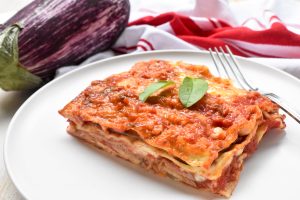
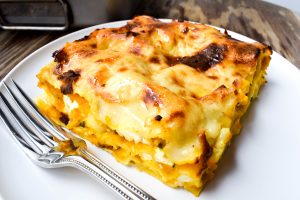 3. Lasagne ‘alle melenzane’ (of eggplant/aubergine)
3. Lasagne ‘alle melenzane’ (of eggplant/aubergine)
4. Pumpkin, sage and ricotta lasagne.
They are all delicious.
So, the only remaining question is ‘how do you complete the best lasagne dish’? What is the icing on the cake when it comes to lasagne? Whatever the filling, be sure to finish with a layer of pasta covered with ragù, Italian tomato sauce or besciamella and a thick layer of Parmigiano Reggiano (Parmesan) cheese on top. As a general rule, all lasagne dishes have a layer of Parmesan cheese on top.
Cooking the perfect lasagne
Cooking the perfect lasagne starts with the right oven temperature. Preheat the oven to 180°C conventional oven/ 160°C fan-forced (350° Fahrenheit/Gas 4). The cooking time will vary depending on the amount of pasta and layers of filling but generally takes 30 minutes to cook. I cook my lasagne uncovered to get the perfect golden colour on top of my lasagne. There is generally no need to cover the lasagne as long as the oven is not set too high.
To confirm that the lasagne is cooked, insert a knife in the centre of the baking dish and hold it there for a few seconds – if the knife blade is hot, the lasagne is ready.
Resting the lasagne
As soon as the lasagne comes out of the oven, it is so tempting to slice it up and start eating – we’ve all been there! The reality is that a good lasagne can only be improved by leaving it to rest for a minimum of 10 minutes. The longer the rest time, the better your lasagne will be – trust me on that! Lasagne is taken from good to great after a few hours resting and tastes even better the following day! Resting your lasagne allows you to cut it into perfect portions and then … the lasagne bounces back better than ever when warmed up. Try it!
We have talked about how to cook the best lasagne, a delicious and very impressive meal. Which lasagne recipe will you choose to cook? Whichever recipe you pick, don’t forget to make extra – yes go ahead and double the quantity you need and make 2 meals out of 1. Left over lasagne is one of our family favourites.
X Happy Cooking and Buon Appetito!
Vanessa Bottaro
Vanessa is Creative Director of the Italian Spoon website and Author of The Italian entertaining cookbook, a collection of home-style Italian recipes and tips for entertaining in true Italian-style. In addition to cooking and taking photographs, Vanessa writes the recipes and blogs to bring the love of Italian cooking to life! The collection of recipes and blogs on the website have been inspired by travels to Italy and desire to share what she has learnt from the great ‘Mamma’s and ‘Nonna’s in her life!
Vanessa is an entrepreneur and wife to husband Simone and the mother of two beautiful kids Dante and Mia. Even so she was born and lives in Melbourne Australia, Vanessa has a deep connection to Italy. Perhaps it is the food, or maybe it is because it is the place where Vanessa met the love of her life, Simone to whom she has been happily married for so many years.
Latest posts by Vanessa Bottaro (see all)
- Italian Christmas menu 2022 - December 16, 2022
- 10 Show-Stopping Roast Ideas - November 18, 2022
- Healthy Italian food recipes - November 4, 2022
Recent Posts
-
16 December, 2022Italian Christmas menu 2022
-
18 November, 202210 Show-Stopping Roast Ideas
-
4 November, 2022Healthy Italian food recipes
-
21 October, 2022Tips to cooking the perfect pasta (just like nonna)
-
7 October, 20226 rules to make the perfect homemade Italian soup

